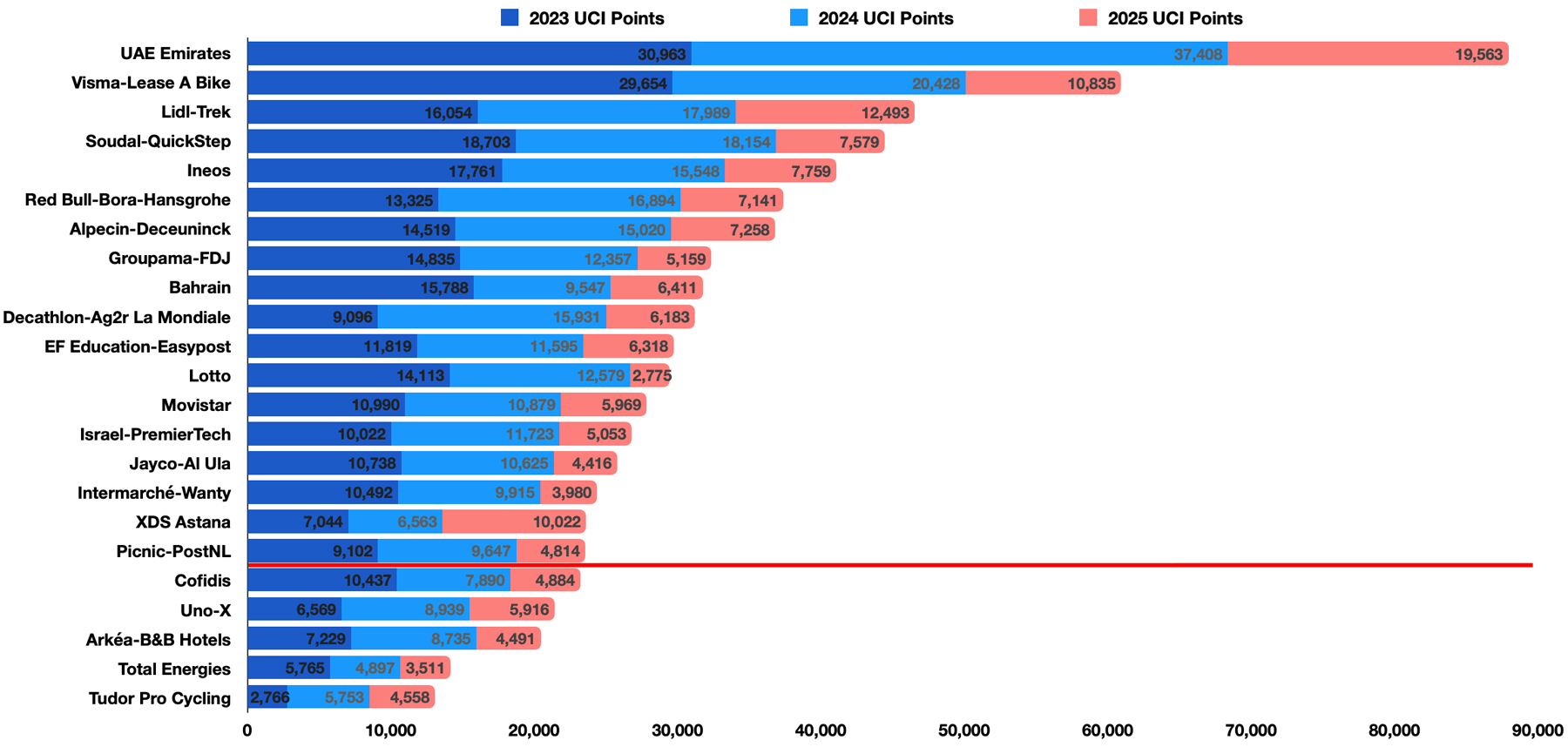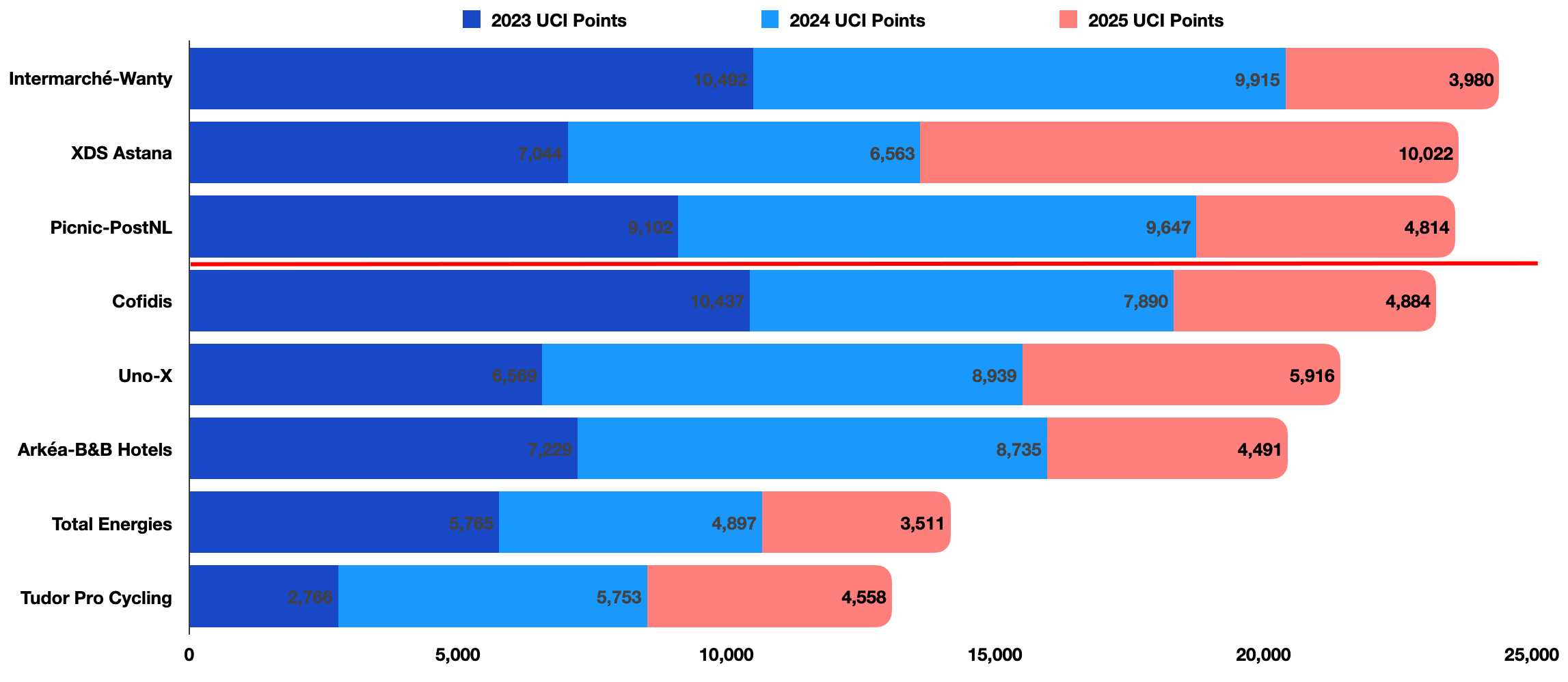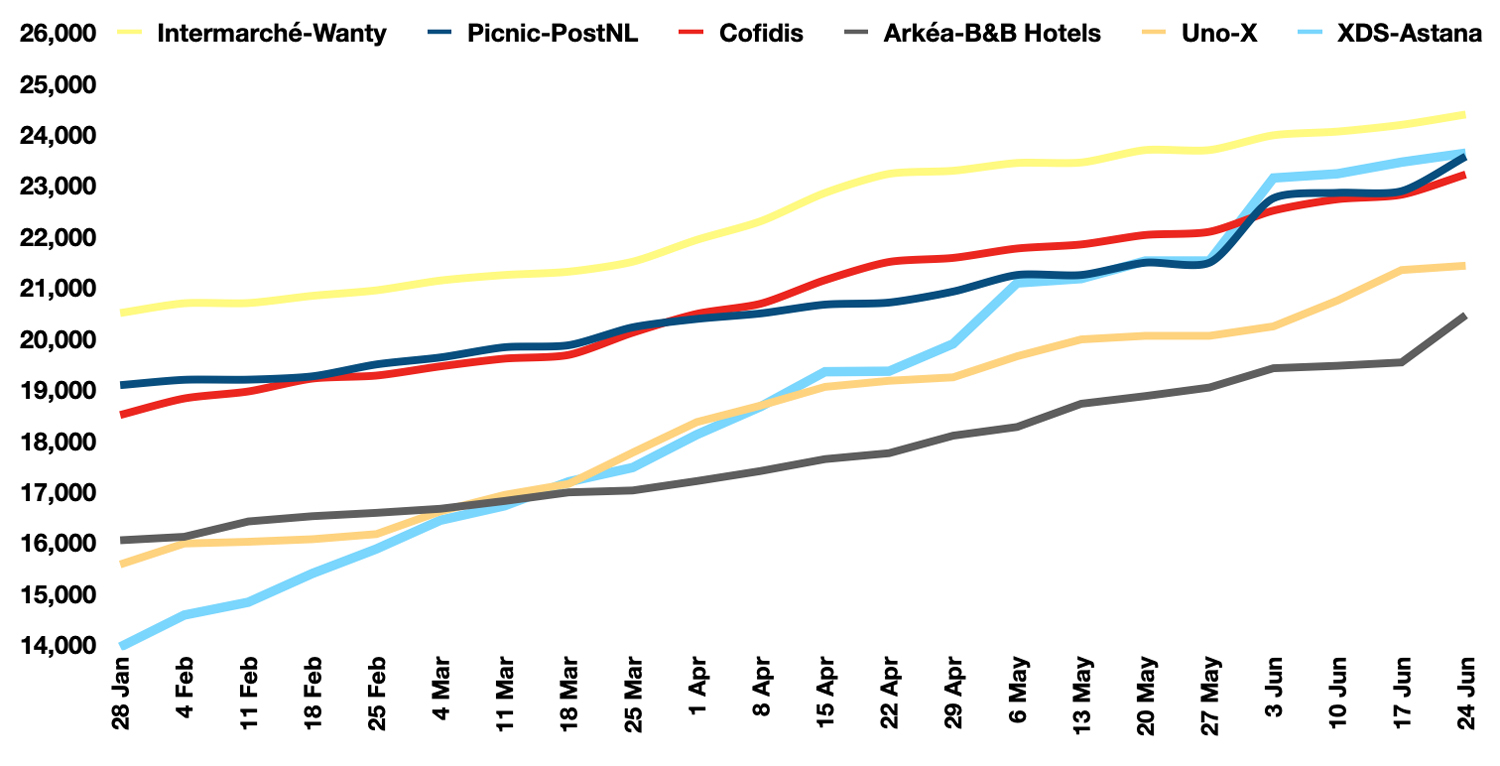Oscar Onley’s great week in the Tour de Suisse has given Picnic-PostNL plenty of points; but so did Alexis Renard’s second place in the Copenhagen Sprint World Tour one day race as both teams jostle to avoid relegation.
It’s too close to call and sets up a tense Tour de France. The high pressure event of the year will be even more stressful for some team managers, including those at Intermarché-Wanty as the team slips down the rankings.

You can see the teams ranked across the three seasons here with UAE’s haul distorting the chart. As things stand current UCI ProTeams Lotto and IPT are well among the top-18 teams and so heading for promotion; while Cofidis and Arkéa-B&B Hotels are below the red line and face relegation. But it’s tight.
Look at Lotto’s troubles this season, just 2,775 points this season, the worst on the chart above by some way. They’re comparable this year to Caja Rural in terms of points, but the Spanish team has a smaller budget, squad and race program.

Zoom into the relegation race with the chart and it’s still tight. There are only 418 points between XDS-Astana and Cofidis, with Picnic-PostNL in between them, a week’s worth of points. The Sino-Kazakh team have lost some momentum in recent weeks with the Dutch team closing in on them, with only 67 points difference.

This chart shows the trend across the season. Look at Intermarché-Wanty they started the season 2,000 points clear of Cofidis, now that cushion is getting threadbare as they sit 800 points away, after a week where Cofidis scored almost 400 points and Picnic-PostNL 700. This means the Belgian team are going into the Tour de France in need results galore from Biniam Girmay not just for their own sake but for the points too.
Arkéa-B&B Hotels had a good week thanks to Kévin Vauquelin’s ride in the Tour de Suisse but remain well behind, the immediate question is whether they find replacement sponsors with news due soon.
2026 Invitations
It’s too close to call the relegation race. But next year the top-3 ranked UCI ProTeams of this season will get automatic invitations to the major World Tour races including the Tour de France. In case they stall and get relegated XDS-Astana are well clear for 2025 with over 10,000 points this season.
Next come Uno-X, also nicely ahead 5,916 points for 2025. But after them come Cofidis, Picnic-PostNL, Tudor and Arkéa-B&B Hotels in a mini-peloton in the high four thousands with 400 points between them. Q36.5 are only a few hundred points further back here too.
It makes it hard to call which team gets relegated, let alone their fate for 2025. For example if Intermarché continue to struggle then their haul from this season may not be enough for automatic invites and they’d be competing for wildcard invites next year.
Conclusion
It’s very close. Cofidis are below the line today but that can change, especially as XDS-Astana’s momentum has eased and Intermarché’s hasn’t.
You may have plans to spend part of July on the sofa with snacks and drinks within reach. Some team managers are going to have their laptops and spreadsheets to hand. This will overlap as you spot team tactics with teams trying to coax riders towards points as much as publicity.

Notes:
- The points tables for all the races, including the Tour GC and stages are here
- Tour de Suisse photo by Cor Vos, via Picnic-PostNL


The thing to remember is that whatever happens, nothing really happens.
For the spectator, the only noticeable effect is the mildly amusing diversion of watching Astana’s multiple riders charging to the line for 7th, but those riders would never have been challenging for the win anyway. It’s been effective in terms of points-gathering, it seems, so we might see other teams start to do this.
Several teams are on the line here. Can Lotto afford promotion? If Intermarché get dropped will Girmay stay? Would Picnic and PostNL stay in the event of relegation or go, taking the women’s team with it.
There’s always this talk, and then nothing happens.
Teams do disappear, but I can’t recall it ever being because of this points system: it’s usually because they lose a sponsor, as is apparently the case with Arkea – and did their sponsor really think they would be in the World Tour? Seems unlikely.
And even if teams disappear, it doesn’t matter to the spectator – new teams appear.
It may not matter, but the stories of teams´ appearing, developing, blooming and eventually disappearing are of (sometimes great) interest to many spectators.
It may not be everyone´s cup of tea, but for many the stories of teams that never win grand tours or monuments battling against relegation can be as much a part of the allure and beauty of cycling as the stories of GT winners.
This is because very few teams have much of an identity outside of diehard fans – the constant change in names/sponsors makes it really hard to follow so for the casual fan, it’s all about the riders.
It´s mildly amusing, too, how the caricature of “multiple riders” of certain teams “charging to the line for 7th” has spread and sticks.
Pray name at least one example of such a race or stage!
If one actually looks at the results, it pretty soon becomes clear that Astana has collected a nice haul of points by the simple art of their best rider winning, podiuming or placing in the top five or so.
It is absolutely true that two riders placing 3rd and 6th earn their team as many points as does a rider who wins the race. Or that it may be motivated to choose a tactic in the final of a race that has a greater probability of resulting in those 3rd and 6th places than a tactic of going all out for the win at the cost of losing all but a pitiful few points for their second best rider.
But the funny thing is that now fans see such tactics chosen when all the evidence clearly shows this isn´t the case!
We had essentially the same discussion just a couple of weeks ago when it was claimed that the reason Jayco came away from the Giro having scored fewer points than certain teams because unlike the latter Jayco doesn´t resort to the tactic of aiming at a maximum number of points by going for a handful of minor placings, instead of having their domestiques work together to get their leader to a stage win or at least the best possible placing.
Yet it was shown that all of those teams would have earned more points in the Giro than Jayco did also if only the teams´ best result for each day and GC would have counted (and this should, in my opinion, have been obvious to anyone who had actually looked at each day´s results).
Astana´s “secret” has been to pick the right races and to go for the win. Or in other words: their tactic has been to have their best rider go for the best possible result. The points earned by their second best rider finishing 3rd or 5th have been a nice bonus, but that´s all.
You
I’ve seen Astana do this.
Thank you for picking apart the J Evan/popular theory.
Some people comment about cycling, others are much more focused on criticising particular commenters.
Why fixate on a total stranger, Kevin? Why agitate yourself? Don’t worry about it.
First and third today (ulissi and VELASCO) not too shabby ,eh?
Is there another 3 year period after this year? I seem to remember there was talk of a change of system or something happening.
Although the upcoming Tour should produce more hilarious moments then usual thanks to the teams attempting to get UCI points, I have to wonder of the effect on potential sponsors. Hopefully for the teams that do get relegated, they’ll be able to survive in one form or another.
Yes, there should be another three year cycle. The only reported change is to the women’s points system which has been changed to resemble the men’s scale next year.
Lotto are in a mess, it seems, thanks to the 3yr/1yr rules – I’d assumed that without a new sponsor, they might have been wise to decline promotion, protect their budget, and carry on picking and choosing races to stay visible. But there’s no way they’re going to be in the top 3 pro teams based on this season’s results, and so they’d miss the big races if they turned promotion down. Their riders’ agents must be busy.
Well, it’s not the rules that are messing with them. They don’t have points… it’s a simple solution. Race for the placings all season long, from Australia to the Asian races in the fall – race, race, race and race for placings. Place whenever you can. Better training anyways to keep racing until the bell, than pulling out and soft pedaling to the hotel.
Just race.
They are struggling with a lack of money. And going to all the races you advocate costs lots of money. This is why they don’t do these races.
Oh yes, racing costs money, and that’s how you get points. Definitely it is expensive, but that’s obvious, and it’s the bare minimum to stay in the top tier. If they can’t pull in sponsorship, then perhaps being relegated is a blessing in disguise.
You can’t have it both ways.
So, it’s not the rules that’s messing with them… it’s their own internal issues – funding and racing for places. You don’t see them in the placings very often.
For example, the Baloise Tour St 15, Israel placed 8th and 10th. Yet, Lotto’s top rider was 15th. This is just one example, but they have to race 100% for the placings of the races they’re at. Maybe they are, but it’s not working.
Anyways, I’m being obvious… it’s a tough situation.
Sorry, that was Stage 5, not 15.
I’ve been following Picnic pretty closely this year, and I’ve noticed the same thing. They’ve had some good performances and results this year, but they have also had a number of races where they barely appeared at all. They were awful at the Baloise Tour; it’s like they didn’t show up at all. Astana has been so great at picking up points wherever they do show up, not just being there to be there.
Picnic have a very young squad (at least their key riders) mixed with a few veterans who are under-preforming. They are hoping their young riders pick up enough points at the big races to keep them clear of relegation. Although this is a bit risky, I am not sure they can do much else: their squad is not built for hunting UCI points at low-level races and doesn’t have the depth of Astana (or the money they have).
If their sponsors stay on board, I think they would be an interesting team to invite (for race organisers) for a lot of WT stage races next year if they get relegated since they have a nice squard of young riders full of potential.
It’s helping to make it a very interesting season… seeing how these relatively minor teams pick up points and place themselves even though they aren’t the main event.
Thanks to Inrng for this coverage too – it is very interesting as a fan.
Exactly, they’re in a tricky place. They really need promotion but may not be able to afford it.
Henceforth all placing points are doubled if handlebar width exceeds 46cm.
But not in jest, this article merits an update after the Tour.
Today Astana scored 195 points with Ulissi 1* and Velasco 3* at Giro Appennino while Intermarchè got 83 from Busatto, Barrè and Colleoni in top20. Picnic and Cofidis were not racing.
The National Championships week will be interesting as races are often impredictable and points go quite randomly. Too bad that NC are at the bottom of UCI points scale.
Astana haven’t done too badly out of the Kazakhstan time trial to start with. 1st, 3rd & 5th totalling 80 points.
And now Astana have got 1st, 2nd & 4th in the Kazakhstan road race (with 3rd place a rider on their development team) so that’s another 225 points. I wonder if the likes of Cofidis & Picnic PostNL are now wishing they were from countries with little cycling competition! Picnic PostNL only got 45 points from 5th & 9th in the Dutch road race and I’d be very surprised if Cofidis get anything like 3 in the top 4 in today’s French road race.
I don’t know why I like PicnicPost but I do: stylish gear, likeable old timers (sorry John Degenkolb), brave riders fighting back after multiple setbacks (Jakobsen), and promising youngsters while Romain Bardet always gave an impression of decency and happy to be there. Here’s hoping for a TdF stage and lots of points.
The white version of Picnic’s jersey was really beautiful, in a peloton of generally poorly designed kit. Harked back a little to the Coop-Mercier jersey with the bold vertical stripes.
The dark blue version of Picnic’s isn’t as striking. Still better design than most of the current though kit, sure, but that’s a low bar these days.
Sublimation printing has ruined jerseys. Being able to slap stuff together on a computer screen and hit “print” seems to have addled designers minds. The very early days of sublimination printing, the designers still designed around striking designs visible from distance – I guess cause a) it was the same designers who grew up working with designing patterns for weaves and panels stitched together; and b) they still didn’t have the computer part in the 80s. So we still had amazing designs like the La Vie Claire jersey, the ’85 Sammontana – Bianchi jersey (excellent 80s design work),the Toshiba kit, etc. But then it slowly but steadily went to shit. Increasingly busy jerseys, colours and logos splatted everywhere – and by the mid 2010s, just little in the way of a cohesive design that was striking enough to recognise from distance (other than the general colour the blancmange blurred into – IF it was different enough from colour of other teams).
I quite like the relative minimalism and retro-ness of the current Uno X kit. I can’t look at that early 90’s Toshiba kit without getting a migraine though.
I’m not sold on the colours, but agree – the Uno-X kit is one of the exceptions, with simple, yet striking (by today’s standards) design. Just.. not quite enough contrast on the colours for me though.
The Toshiba kit was pretty good for the era – 1991. Lot of striking designs still, but printing meant they had nearly all become very very busy with sponsors and graphics. The Toshiba kit was relatively uncluttered. A Toshiba jersey today still looks pretty good, whereas if you went out wearing a Castorama or Equipe-Z jersey, you’d look terrible. The Kelme jersey was still OK, but the earlier ones from seasons before where the (primary) design was woven in rather than printed still look better today. Even with the same general design, the technology (printing) just leads to shittier looking jerseys – it looks _cheap_ compared to woven, cause it is! The ink is never perfectly on all the fibres, unlike a woven design where the design is (obviously) embedded in the fabric. And then the printing just makes it irresistably easy to add /far/ too much logo clutter (woven designs, you need to sown on panels, or use flocking, or chain-stitching – printing it’s just so /cheap/ to add more, and more, and more and more logos and graphics… so they did!).
The trailing off of XDS-Astana point accumulation is something I speculated on early in the season; wondering if they were trying to bank as many points in the early season with the expectation of leaner times later. Do they have a deep enough team depth/marquee riders to do well in the grand tours or will it be a regular scrabbling for minor placings to “limit their losses”?
I will say I’ve enjoyed watching them them season. Lots of action and risk taking. Not always for a win but points well earned.
I feel their team is well suited to the Italian autumn classics. And since they have a Chinese sponsor, they’ll probably also send a strong team to Guanxi, a race the stronger teams often send the b-squad to.
Astana did quite well at the Giro. I thought it was a very good strategy to try for the KOM jersey from the beginning (it is worth a stage-win in UCI points). I think they will do this again at the Tour. I don’t know why more teams don’t try to do this.
I’m perplexed that for years now grand tour KoM jerseys are quite often contested by precisely one rider.
Surely, being able to say ‘I was KoM at the Giro d’Italia’ is quite a big thing? And yet only Fortunato tried to win it.
Happens a lot in the Giro and Vuelta. And even at the TdF nowadays, top climbers don’t often try to win it (just those who happen to get it by going for GC).